Aggressive creatures can have stars representing their level. One-star creatures have double the health and deal 150% damage, while two-stars have triple the health and deal double damage, and can therefore be difficult to fight. Using the right strategy will make killing them much easier.
Meadows[]
Boar[]

Boars fear fire and avoid contact when in the presence of such. However, if provoked, they will alternate between charging in and retreating. Melee or range attacks work best when engaging with them.
Neck[]

Necks fear fire and avoid contact, but will attack if provoked. They will charge and take a bite before retreating then countering with another bite. Using a torch may prove effective, but typically any weapon should suffice.
Greyling[]

Greylings actively avoid fires. They will path toward the player and attempt to attack three times before running away in a circle, and then repeating. They are easily killed with torches and other fire-related weapons, however, any weapon such typically suffice.
Black Forest[]
Greydwarf[]

Greydwarfs actively avoid fires and will throw small rock projectiles if they are out of melee range. They are easily killed with torches and other fire-related weapons, however, any weapon typically suffices.
Their stone-throwing can obstruct attempts to raise crops such as carrots and turnips, or replant trees, since they will target the individual plantings for destruction. Fields should either be fenced or placed out of greydwarf range.
Greydwarf brute[]
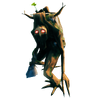
Brutes are not afraid of fire and their large stone clubs can cause a great deal of damage to structures. They are more easily killed with torches and other fire-based weapons. An archer with fire arrows who kites a Brute from a distance will see it burn to death fairly quickly. It is recommended with lower-tier weapons and armor to actively parry or dodge a Brute's swings.
Unlike Greydwarfs, they lack a ranged attack which makes them helpless if they cannot physically reach their targets.
Greydwarf shaman[]
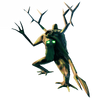
Unlike Greydwarfs and Greylings, they are not afraid of fire, and can cause lingering damage with their poison attack. When attacking a Shaman, they are more easily defeated using torches and other fire-based weapons.
In addition, Shamans will also use a healing pollen to regain theirs and other faction-related creatures' health over time. Shamans should be prioritized first to maximize efficiency when dealing with patrol squads and raiding groups. Due to the faction mechanic, shamans can heal trolls as well.
Note that when injured, the shamans will spray their healing pollen directly upward about a meter and a half, and it will not take effect until it drifts back down. Two quick arrows or a strong melee attack will often kill a shaman despite its attempts to heal itself.
Troll[]

Troll attacks are relatively slow and easy to dodge by utilizing side-strafing and rolling. They have an exceptional amount of health, able to cause a lot of damage, especially against ore deposits, rocks, structures and trees. Their mobility is limited due to their large size, and they cannot pass through narrow gaps. Some trolls wield tree trunk clubs, while some seem unarmed, but toss boulders at the player from a distance. Unarmed Trolls will smash the ground with their fists if you get close to them.
Outrunning a troll is problematic, as trolls move faster than a running (but not sprinting) player. However, they are slow to turn, so one can avoid their attacks by running around obstacles (like trees, fallen trunks or stones). As with the other enemies, trolls are hostile to creatures from other factions, so an occasional skeleton can be used as a distraction to break distance and escape. Angry trolls kited into the Swamp biome usually break off pursuit quickly, being distracted by attacks on swamp creatures such as leeches.
Trolls are not hostile to greydwarfs and can even be healed by greydwarf shamans. It is helpful to dispose of those quickly while evading the troll to make maneuvering - and fight - easier.
Trolls are weak to pierce damage, so bows and spears are a particularly effective way to deal damage. Using fire arrows is perfect, but note that water or rain can extinguish the fire, negating any lasting damage. Using a shield with high parry power (bronze or better) might also consider parrying the troll, although this takes some practice. Players with end-game armor take minimal damage from troll attacks.
If a Troll is pulled to the entrance of a dungeon like Burial Chambers, it can be attacked while it runs around the entrance. When the Troll is about to attack, move backwards to enter the dungeon. The same back and forth tactic can also be used to kill a troll in its home cave; a troll in a cave will not pursue the player to outside the cave.
Trolls are all but helpless when confronted with deep ditches, and sometimes fall into ditches or pits, effectively neutralizing themselves. Since a troll can quickly damage structures, digging ditches or making ramparts around vital settlements is very useful to keep them at bay.
The unarmed Troll's ground slam attack is bugged and does two instances of damage when hitting diggable terrain. The first is the main attack, doing up to 70 damage unmitigated, the second deals 50 damage.
Ghost[]

They are slightly tougher than Skeletons but do not pose a major threat on their own. Their melee attack can be parried with help of the sound they emit.
Skeleton[]

Skeletons have a chance of spawning with a Bow (20%), only a Sword (40%), a Sword and Wood shield (20%), or a sword and Bronze buckler (20%). Fighting a Skeleton effectively is relatively simple, requiring a standard dodge or parry tactic, then delivering a strike with a blunt or fire-related weapon.
Rancid remains[]

Fighting Rancid remains effectively is relatively simple, requiring a standard dodge or parry tactic, then delivering a strike with a blunt or fire-related weapon.
Their melee attack inflicts Poison damage.
Root[]

Roots deal high damage with their melee strike, unless the player has upgraded to Bronze armor.
Their attacks are relatively easy to avoid by moving out of range since they cannot move beyond their fixed position. Trying to kill all of them is not effective considering how often they are summoned.
Swamp[]
Abomination[]

If you want to tank an abomination, get an iron tower shield and an axe, and try and stay closer to the abomination's right leg, since that is the lighter of its' three attacks. Block each attack as they come in with the shield, and then counter by hitting the abomination with your axe. It is a slow process, but the creature's attacks are easy to block, and as long as you are not being attacked by other mobs at the time, you should not have a problem.
If you are able to successfully parry an Abomination attack when using the above strategy (can be done with Banded Shield), and the Abomination is standing over the fire at the time, the fire damage it takes will be critical hits and finish it off in only a couple ticks.
You can lure Abominations over the flame geysers to deal large amounts of fire damage without using any weapons.
The easiest / cheesiest strategy is to climb / build to the top of a sunken crypt which the Abomination can neither climb nor destroy. At some point after some walking around it will come near the crypt. From there one can hit it with a sword etc. without being hit by it at all.
Abominations are incapable of crossing deep ditches; they are blocked or get stuck. An archer can then slowly burn them to death with fire arrows in perfect safety. As with Trolls, a certain amount of time invested in preparing the likely battlefield will pay off handsomely.
Blob[]

Blobs attack by leaping large distances towards the player before releasing a poisonous, area-of-effect gas cloud once in close proximity. The poison cloud cannot be blocked. Once poisoned, the player will take heavy damage over time unless using a poison resistance mead. The Blobs make an inhaling sound just before thew spew their poison attack.
Although Blobs are resistant to pierce damage, it is safer to take them out from a distance with a ranged weapon such as a bow. Alternatively, with good timing, a club will kill a blob in one hit.
Oozer[]

Oozers attack by leaping large distances towards the player before releasing a poisonous, area-of-effect gas cloud once in close proximity. The poison cloud cannot be blocked. Once poisoned, the player will take heavy damage over time unless using a poison resistance mead.
Although Oozers are resistant to pierce damage, it is safer to take them out from a distance with a bow. Most blunt weapons will not kill an Oozer in one regular hit; however, an Oozer may be killed in one hit with the alternative attack (default keybind: mousewheel click).
When the Oozer dies, it spawns two Blobs. Spawned Blobs are momentarily vulnerable to attack due to the way that the backstab mechanic works, because they will not immediately perceive the player upon spawning.
Draugr[]
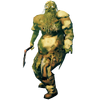
Draugr have a chance of spawning with an Axe (75%), a Bow (25%), no Shield (33%), a Wood shield (33%), a Banded shield (33%), no Helmet (25%), a Leather helmet (25%), a Bronze helmet (25%) and a Iron helmet (25%).
If they detect an enemy nearby, they emit a quick roar before charging in that direction. They attack either with melee swing if they have an axe or an accurate arrow volley if they have a bow. Blocking and parrying a Draugr attack is important as it will stun them long enough to land multiple strikes.
Draugr elite[]
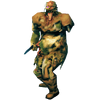
If they detect an enemy nearby, they emit a quick roar before charging in that direction. Blocking and parrying a Draugr attack is important as it will stun them long enough to land multiple strikes.
Leech[]

They are only aggressive while in the water and will try to flee if forced to land. Their melee attack inflicts mostly Poison which makes Poison resistance mead effective against them. Leeches are quite difficult to spot in the gloom of the swamp, but will disturb the water as they swim through it. Look for moving water splashes to spot a leech. Because the player cannot attack with anything other than fists while swimming, falling into deep water in the swamp is frequently fatal. The player can use a hoe to create dirt paths above water level to avoid leech attacks. If the player lures leeches to the shoreline then the player can attack the leeches from safety with things like spear throws, bows, or sometimes the secondary attack of a mace.
Leeches are immune to spirit damage despite belonging to the undead Faction.
Surtling[]

Surtlings take constant damage while in contact with water which allows creating coal and surtling core farms at Fire geysers by lowering the terrain. Use Frost weapons to deal more effective damage against them.
Wraith[]

Wraiths only spawn at night. To avoid a wraith attack, avoid the swamp during the night. Wraiths take damage-over-time from silver weapons.
While Wraiths may seem terrifying to get close to, parrying them with a shield is an option and is actually relatively easy, as their only type of attack is a claw swipe. Just be wary of other enemies while fighting these. They often float fairly high up before they spot a player. Be careful not to be too fixated on ground-based dangers (such as Leeches) at night.
Wraiths are fast and are not slowed down by water, so it is possible to separate them from groups (and possibly just outside the swamp) where they become much less of a threat. When hunting for wraith a small 3x3 platform on top of two wooden poles can be built to provide protection. Surround the platform with Stakewall attached on all sides save for a stepladder to climb up on the platform.
Mountain[]
Wolf[]

Wolves can be dangerous, as they move and attack very quickly. They have low health and exceptionally long stagger duration which makes them weak to attacks. However, their fast attacks and speed makes them dangerous, especially when in groups and a higher Creature Level. They attack very aggressively and leave no room for breaks between each attacks. Wolves also run as fast, if not faster, than a typical player, and will pursue relentlessly until the player runs out of stamina. The only way to effectively escape a pursuing wolf is to quickly gain or lose elevation to break the wolf's pathing. Otherwise the player will run out of stamina and be unable to fight and unable to run.
Blocking their attacks will give players enough time for one fast attack only. Players should block again afterwards, or the wolf will bite them. To effectively fight wolves, players either should use a bow or try to parry wolf attacks which gives players more time to attack.
If forced to face up against multiple wolves, try to pick off one at a time if they are separated from each other. A swing from a fully upgraded Iron sword is enough to stagger a wolf in one hit. If surrounded in proximity, the best strategy is to use attacks that have a wide range, such as a two-handed club, an atgeir, or a battleaxe.
If a starred wolf is among the group, it is imperative to focus on taking out the starred wolf first; its buffed damage can immediately stagger the player and is near-fatal in 2-3 hits. Parrying first is recommended as they would not stagger upon an initial hit. In the face against other lesser wolves, it might be better to receive a few hits while fighting the starred one. With fully upgraded Swamp-tier or other light armor, and a cape, the normal wolves inflict around 20-30 damage.
Wolves with star ratings appear at night and will de-spawn during the day if not in range of a player.
Drake[]

Drakes attack by shooting 3 frost balls that inflict the Frost Effect, which slows the player for ~2 seconds. After each burst the Drake will patrol a small circle and repeat its attack.
They are fairly easy to dispatch with a bow, strafing to avoid frost breath. They can be underestimated due to usually encountering them with a frost resistance. During the raid event, they can be encountered outside of the Mountain biome. This is particularly dangerous during rainstorms or in the Swamp biome, where the Wet Effect is active which multiplies their frost damage.
Fenring[]
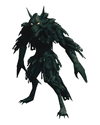
Fenrings have three regular attacks and movements: a regular swing, preparing for attack with a crouch move followed by a pounce with a swing/slam and a howl that is primarily for intimidation and to call nearby wolves. Fenrings take damage-over-time from silver weapons.
When parrying a Fenring, it is important to remember that they will almost instantly recover, thus striking quickly once they are staggered is advised.
Stone golem[]

Stone Golems have a high amount of health and resistance against most damage types. They can have either boulder or spike arms that determine their available melee attacks. All of their attacks deal lots of damage and knockback.
Boulder-armed Golems do 2 types of attack: One-hand front slam (light, fast): 110 Blunt, 200 Terrain and Two-hand front slam (strong, slow)): 110 Blunt, 200 Terrain.
Spike-armed Golems do 2 types of attack: Frontal spike attack (light, fast): 110 Pierce, 200 Terrain and 180 degree spike swiping attack (strong, slow): 110 Blunt, 200 Terrain.
Stone Golem will perform up to 3 attacks between each instances. After that, they will walk away or around the player briefly before re-engaging. This offers up a few free attacks before returning to the defensive.
The best way to kill them is to parry their light attacks with a shield and then use the 3 hit combo with Iron mace or Porcupine to deplete half of their health during the stagger. This does not work against the slower attack because it has a very low stagger duration.
Pickaxes are another good way to kill Golems because, being made of rock, picks deal 2.5x damage against them (0.5x comes from the Pierce damage). However, slower attack speed, lower base damage and lack of hit combo means that Iron pickaxe will deal less damage than the maces. Pickaxes are also harder to use because the shield cannot be equipped at the same time and requires manually switching the weapons. On top of that, pickaxes very easily get a 33% damage penalty when the attack hitbox intersects with the ground. This can be mitigated by doing jump attacks, having higher ground or standing very close to the target but it's not reliable.
If you have a good bow, a high archery rating, and obsidian arrows, it is quite possible to chip away at the health of a Stone Golem until it collapses in a heap. Digging a trench between your position and that of the Golem will ensure that the Golem can do nothing about this, though it can be very time-consuming.
Another tactic is dig a hole and then use Abyssal harpoon to drag them in. This allows jumping on top of them and using a pickaxe to attack them. This is very effective against the spiked variants because they cannot hit above their head. However, the double damage from stagger is missed with this tactic. Higher terrain can also be used to jump on top of them but it is very easy to fall off when the Golem is moving.
They can also be left in the hole which prevents other Stone Golems spawning in the nearby area. If the player is exploring, building a base, or otherwise occupying the area, leaving the Golem nearby can act as a fallback tactic. If the player is attacked, running to higher ground near the Golem's space will cause wolves and Drakes to turn their attention to the Golem, giving the player time to recuperate and strategize. Or, in the case of wolves especially, the Golem will often simply dispatch them itself.
Players without Wolf Armor or better and good buffs should be cautious due to the Golems' high damage output. The Forsaken power of Bonemass can be used to make the fight much easier. Since attacks from Stone Golems are slow, it is relatively easy to maneuver behind them while they attack and strike them from the rear.
Bat[]

Bats are weak and unless an explorer is unprepared, mainly an annoyance. Their flight patterns are quick and erratic and they quickly attack once before fluttering away, giving only a brief window to strike before they are out of range. Their small size and erratic movements makes shooting them with arrows very challenging and after attacking they often fly behind icicles or indestructible rock features hanging from the ceiling before coming back for another attack run.
While they do not do much damage, they do attack in groups of 4-10 which typically spawn in vertical shafts. An explorer might be attacked while attempting to descend or while they are precariously perched on an edge. Due to some weapons "pulling" the character forward when attacking, a careless player may find themselves taking a quick trip to the bottom of the cave, dying at the hands of the bats' greatest ally: gravity.
Alert explorers will recognize the sounds of the bats and be able to kill them as they approach with a single hit, though often the hitboxes of weapons are in the wrong vertical plane to attack the bats if they attack at a steep angle from above or below. If the player's first attack misses, blocking and waiting for the bats to draw near again may be the best option due to their tendency to fly up and away and hide behind an obstacle on the ceiling, making ranged attacks difficult. It is easiest to fight them with a quick striking weapon such as a sword or knife while you are on flat ground and your back in a corner to minimize their angles of attack. Weapons with a large area of effect attack such as Stagbreaker, Iron sledge, or the secondary attack of an atgeir are very effective at clearing out a swarm. Weapons with narrow arcs such as spears or the atgeir's primary attack can make it difficult to connect a strike.
If at all possible, do not try to fight a bat swarm inside or near one of your own structures. Their erratic flight patterns and the somewhat inexact damage dealt by most weapons will have you smashing more of your own stuff than bats. They are best fought in a wide-open area. If you have a covered pen for tamed animals, make sure that all openings are either very narrow or are covered with iron gratings.
Ulv[]

If you spot them from a distance, a well placed arrow may do the trick before they are aware of your presence. Otherwise, silver weapons are excellent up close. Just beware their powerful pounce that delivers significant knockback and could send an unprepared warrior tumbling down into a crevasse.
Cultist[]

Cultists are very alert to their surroundings and will move to sources of noise making sneaking up on them difficult if the player is breaking objects or fighting creatures nearby. Despite this, they will not open the doors that separate their worked stone lairs from the natural caves.
Their opening attack is a burst of flame that explodes before them. This attack will do initial fire damage and leave players burning for 5 seconds. This attack cannot be blocked or parried and encompasses a wide arc. After using this attack they will attack twice with a flaming claw slash that will also leave the player burning for 5 seconds in addition to the physical damage. They will cycle through between the attacks with the same flame/claw/claw cycle as long as they are alive or lose track of the player which resets their cycle.
Dodging, rolling to the side, or backpedaling can get the player out of the way of the flame burst since it is a relatively short-range attack. It is also blocked by solid objects such as a wall or door.
Their claw attacks can be blocked or parried but like Fenrings, they are only staggered for a very brief period of time.
If a player has access to Fire resistance barley wine then the Cultist's flame attacks and burning affect from their claws are very minor, though the claws still do physical damage. They are very susceptible to spirit damage and poison damage. So silver weapons, including Frostner, are very effective. poison, silver, or needle arrows are also effective. Silver arrows are the most effective, but the resources may be probably better spent crafting or upgrading a Draugr Fang to use with a different arrow type, preferably poison, since poison arrows stack with the poison effect of the Draugr Fang.
Plains[]
Deathsquito[]

Entering the Plains early to hunt Lox for their meat may be desirable, but an encounter with a Deathsquito is inevitable and a poorly equipped player will have trouble surviving without a good strategy.
After flying next to their target, Deathsquitos will attack with very little delay, after which they will fly away and circle their target for several seconds before attacking again. They only have 10 HP and die relatively easy from a single strike. The main problem to overcome is their almost unavoidable attack that deals up to 90 damage, which will stagger players with too little health or players that attempted to block without having enough block power.
If the player has over 90 block power then dealing with Deathsquito's becomes trivial, as blocking and counter attacking will kill them easily without the player taking damage. Parrying with a Bronze buckler or better will have enough block power, but they are immune to stagger and parrying knocks them back a little which can make it more difficult to land a counter attack before they fly away.
Using a bow can be very effective. Players can kill Deathsquitos in one shot from an early level. They can be sniped from a distance, or if they are already attacking the player, a fully drawn bow can kill a Deathsquito accurately just before they get close enough.
With good timing with a melee weapon, they can be killed without taking any damage if the player strikes them during their "swoop". 2-handed maces such as Stagbreaker are the most forgiving on timing due to their effective range, but some practice may be needed due to the swing delay. Simply having enough health and armor means that a player will not stagger from a Deathsquito attack, allowing a counterattack at the cost of lost health. They will always miss when they try to attack a player running away from them that has no movement speed penalties from weapons and armor. The Root armor's pierce resistance can also protect the player from the Deathsquito's attack.
They can fly over walls, which can be problematic for players setting up bases in the Plains biome. However, there are certain build pieces (e.g. wooden beams) which the deathquito will not recognize as obstacles and will not try to fly around, bumping into them instead. If the top of the wall has complicated geometry (e.g. an overhang) created using these pieces, the deathquito might not be able to navigate the top of the wall, protecting the player inside the base. Note that floor and roof pieces cannot be used for this purpose as deathquitos can recognize them and attempt to fly around them.
Lox[]

Lox have extremely high health and damage output and are resistant to blunt and slash damage. Swords and most maces deal minor damage to lox as a result, whereas arrows, polearms and spears are more effective. A Porcupine does excellent damage and stagger to lox because of the pierce damage component. Due to their large size, lox have trouble navigating narrow terrain and can easily be outmaneuvered by the player.
Lox are capable of attacking while swimming, making them a hazard to swimming players and boats. Lox have two attacks: a short range bite attack and an area-of-effect stomp attack which it will always use as its first attack. Unless the player has strong armor, the lox will still do heavy damage through a shield. They have terrible vision and hearing to a degree where it is possible to perform a sneak attack on them without crouching. If hit from extreme range by archery, they will sometimes give up chasing their attacker after a few moments and go back to their original position, which can be frustrating if you are trying to pull them into an area where a kill would be safer. It is sometimes possible to evade an attacking lox by running onto a shadow some distance from the lox and crouching in it.
Fuling[]

Equipment
Fulings wield different weapons which determine their damage types and whether they attack in melee or from a range. They also have 33% chance to a have a shield but this is purely cosmetic.
- 33%: Sword has a melee attack with slash damage.
- 33%: Club has a melee attack with blunt damage.
- 17%: Spear has a ranged attack with pierce damage.
- 17%: Torch has a melee attack with blunt and fire damage.
General
Fulings engage by circling around their target player. After a short while, they will move in for three melee attacks or use a ranged weapon, then repeat the process.
Zero-star fulings can be staggered with a single swing of a fully upgraded Silver sword or a Crystal battleaxe. A hit from the Draugr Fang bow can stagger lock them even with low-quality arrows. In general, try to pick them off one by one as they approach isolated. Take care when facing against starred Fulings; it is recommended to parry them first before attacking. Secondary attacks with swords or maces may potentially stagger them, but it is more riskier.
Due to the Fuling's height, they are susceptible to being submerged in water than an average height player. Try luring them over to a body of water like natural rivers or over the ocean shore to force them to wade, slowing them down and making them easier to isolate or shoot with ranged weaponry.
Melee
Fulings have very high attack damage and are extremely dangerous for unprepared players. A player may quickly die even with fully upgraded armor and the best food in the game. However, most Fuling attacks have a relatively short range and can be avoided or parried with some practice. Because Fulings may counterattack during the player's own attack animations, the player must choose carefully when to attack. Due to the short height of the Fulings, a player's melee attack may miss when standing on uneven terrain.
Ranged
A fully upgraded Huntsman bow along with Frost arrows or Needle arrows can one-shot a standard Fuling while undetected. Frost arrows have the further advantage of slowing them or even bringing them to a momentary halt. Silver and obsidian arrows are still effective, but have a lower chance of killing them instantly.
Due to the danger posed by large groups of attacking Fulings (which can kill a player in a matter of seconds), whittling down the enemies in a Fuling Village using ranged attacks is a sensible strategy. Individual Fulings or small groups can be easily baited into charging directly at the player if engaged with archery at extreme range (a direct hit is not necessary to get their attention). They can also be lured in by briefly digging or chopping at trees, both activities that attract their attention. This gives plenty of opportunity to kill them as they try to close, especially if they have been slowed down by frost arrows.
A building in the Plains that provides some cover and an elevated position to snipe from can be used to farm Fulings if it is surrounded by a deep ditch. Ordinary Fulings on patrol that detect the player in such a position, or are led back there by the player attracting their attention and then retreating quickly, will try to attack but find it difficult, since only the relatively rare spear throwers have ranged weapons. Fulings tend to fall into player-dug ditches due to difficulty in detecting their exact position, and once they have toppled into a deep ditch, they are completely helpless and can be shot to death at the player's leisure. Remember that digging is an activity that attracts the attention of Fulings; be sure to clear the area before beginning to make a ditch.
Groups
When fighting multiple Fulings, using melee weapons with high knockback (such as clubs) can make their attacks miss when standing on even terrain. If choosing to fight with melee weapons, using either Porcupine or Frostner is recommended: of the two Porcupine deals more raw damage but the slowing effect on Frostner can be useful for breaking up crowds and slowing down incoming attacks. The atgeir secondary attack and two-haneded club primary attack are also very effective against groups of Fulings. If there are any Fuling shamans, spear throwers or Fuling Berserkers, the player should kill them first, or focus on parrying their attacks. A thrown spear can be dodged by quickly changing direction with the correct timing; watch Fuling spear throwers carefully, since they clearly telegraph their attacks.
Because the player can be hit by multiple attacks simultaneously, a single misstep when fighting a group of Fulings can lead to a quick death. Running away is always an option, although care must be taken for the ranged capabilities of the spear throwers.
Fuling berserker[]

Fuling berserkers have three attacks, all of which are able to be parried: An attack that swings from right to left, a delayed attack that swings from left to right, a roar, followed by three consecutive overhead head slams. Missing the parry timing on the triple overhead slam attack is frequently fatal. Starred berserkers deal heavy damage and can easily stagger and even kill the most well-armored players with good buffs.
Fuling shaman[]
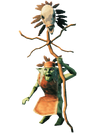
Fuling shamans have three abilities including a melee attack with their staff, a projectile fireball attack and a protective spell that shields them and nearby allies from a set amount of damage. Their magical shields can be damaged by weapons which will render them vulnerable to melee and projectile attacks once again.
Growth[]

Growths has a ranged attack which instantly inflicts Poison and Tarred status effects. They also have high distance leap which they will use to come to melee range of their target. They have low health which makes them easy to kill with ranged attacks. Their ranged attack shoots six projectiles which can deal very high damage on a close range.
Growths have low health which makes them easy to kill with ranged attacks. Silver arrows are the best ammunition, and are superior to Fire arrows dealing 46 damage (26 pierce plus 20 spirit, over three seconds). Growths are undead, and thus susceptible to spirit damage; silver arrows inflict more total damage, which helps to kill growths before they can trap and kill their targets. Lastly, Needle arrows inflict a total of 31 damage, as growths receive half damage from piercing.
If there are any lox in the vicinity, attracting the attention of growths with long range arrow fire and then kiting them into the lox is an excellent method of dealing with them. The two creatures will fight to the death and the survivor will usually be heavily damaged.
Growth's attack covers their victims in tar, slowing them significantly. However, rolling still moves at the same speed while tarred, so with good timing and enough stamina, a player can dodge attacks until the tar effect wears off. Their ranged attack consists of six high damage projectiles which cover a moderate range and have significant arc. The projectiles poison on anything they hit, including trees (though they do not take damage).
Under the influence of Poison resistance mead, being hit by a single projectile in Troll armor is survivable. Being too close or not moving during the attack can easily result in being hit by four projectiles, which is not generally survivable. When not under the influence of Poison resistance mead, a single projectile can quickly reduce one's health.
The projectiles target the player's location after a delay and are very slow, making strafing a viable strategy for avoiding the projectiles. The projectiles only travel farther than the target's position if traveling down a slope. In other situations, the player may be able to avoid damage by sprinting backwards, if strafing is not an option. The projectiles can be blocked or parried with a shield, although this will quickly drain stamina.
Mistlands[]
Seeker[]

Seekers are the most common enemy found in the Mistlands. They are resistant to all physical types of damage (slash, pierce, blunt) but have no resistance to elemental attacks, so elemental magic attacks or weapons with elemental damage such as the Mistwalker are the most effective. With Carapace Armor, common Seeker attacks can be parried with nearly any weapon, which will allow the player to counterattack for heavy damage. One-star and two-star Seekers deal heavy damage and may instantly stagger even a fully-armored player using a Carapace shield.
A Seeker's flying attack has high speed and will allow it to quickly close the gap even for a sprinting player. On the other hand, a Seeker crawls on the ground slower than a player. When attempting to flee from a Seeker, wait until it lands on the ground before sprinting away.
Seeker brood[]

Seeker broods will die to most weapon attacks in one hit. Area-of-effect attacks are extremely effective against Seeker Broods.
Seeker soldier[]

Seeker Soldiers are unusually durable and are resistant to all physical damage. Attempting to kill a Seeker Soldier using bow or crossbow without elemental damage is resource-inefficient and will take a long time. The most reliable way to kill a Seeker Soldier is to parry its attacks and attack after parrying (even when using a magic weapon, because parrying multiplies the damage dealt). However, Seeker Soldiers deal heavy damage if the parry timing is missed, and will also quickly destroy the surrounding environment and buildings with its large area-of-effect attacks. Seeker Soldiers have a weakpoint on their underside.
In an Infested Mine, a Seeker Soldier is sometimes too wide to pass through certain narrow passageways, and can be attacked from distance. Seeker Soldiers can frequently be found at the top of a spiral staircase setpiece, and be difficult to bypass. In this circumstance, use of the Bonemass Forsaken power is extremely helpful.
If the player is inadequately prepared to face a Seeker Soldier, it cannot fly and therefore can be easily outrun.
Dvergr[]

Directly attacking a dvergr settlement will result in the dvergr in that immediate area becoming permanently hostile to the player. Over time, however, most dvergr settlements will be overrun by attacking Seekers, especially where the settlement does not have any dvergr mages.
Because dvergr are naturally neutral to the player, the player can choose when and how to attack them.
Gjall[]

Gjall attacks deal blunt and fire damage in a fairly large area of effect. The lingering fire effect may result in the player taking more damage than expected; Fire resistance barley wine is a big help when fighting Gjall. They additionally summon Ticks to attack the player. Gjalls are most efficiently killed by attacking their weak orange underbelly, perhaps with an Arbalest.
It is practically impossible to kill a Gjall using melee weapons. Even if the player manages to jump on top of a Gjall, it will "shake off" the player.
Gjall attacks will not damage or destroy Ancient armor or Giant Remains. The player can temporarily take refuge inside these formations. However, the area-of-effect for the Gjall attacks will still damage the player through terrain. In a pinch, even a Yggdrasil shoot can provide cover from Gjall projectiles.
Tick[]

Individual Ticks are easily dealt with. They are vulnerable to pierce damage and thus weapons dealing particular damage type such as the Porcupine will reliably kill multiple Ticks in a single hit. If a Tick attaches itself to the player, it will begin to deal heavy pierce damage over time. Attached ticks can be reliably removed by using a combat roll. The default keybind: block (RMB) + jump (spacebar) keys. Alternatively, the player can attempt to use area-of-effect damage to kill the attached Tick, or (with the right angle and timing) parrying the Tick's attack. The Root armor's pierce resistance provides great protection against Tick attacks.
Ashlands[]
Fallen Valkyrie[]

[Strategy placeholder]
Charred Warrior[]

Charred Warriors have a somewhat slow walking animation, meaning they can be outran easily.
Warriors have different attack animations, such as a forward thrust or a delayed swing. These make parrying less predictable before their animations are learned.
Charred Marksman[]

Charred Marksmen have two attacks, a burst shot when the player is farther away, and a single direct shot when the player is closer. The direct shot can be parried, akin to a Draugr with a bow.
They are best dealt with by attacking them in melee range, rather than with a ranged weapon, due to their resistance to Pierce.
Charred Warlock[]

[Strategy placeholder]
Charred Twitcher[]

[Strategy placeholder]
Morgen[]

[Strategy placeholder]
Bonemaw Serpent[]

[Strategy placeholder]
Asksvin[]

Asksvins have two attacks, a bite when the player is in melee range, and a leap. They can also run quickly, and can thus be considered more dangerous than Charred.
Their leap deals significant knockback, which may push the player into lava. For this reason, they should be dealt with before traversing lava, as they can run directly on the lava and knock players off Basalt bomb platforms.
Volture[]

Voltures will attempt to get behind the player and attack with their talons. If the player turns toward the Volture to attack it, it will attempt to fly up in the air can get behind the player again. Additionally, Voltures are among the fastest enemies in the game and can outrun a player in light armor with the full effect of Wind Run, making them especially dangerous to players with very low health.
Voltures deal little damage and do not have very much health, but their speed and tendency to get behind the player can make them a nuisance (and a threat in larger numbers). Care should be taken when fighting other enemies when nearby Voltures, since the latter can potentially get behind the player and block them in.
Voltures can only be encountered in two locations in the Ashlands biome: around Volture nests (where several may spawn, but only one time: they will not respawn there periodically), or randomly in areas at or below sea level. Besides one-time encounters around nests, this does mean that Voltures are encountered chiefly at the coastline of the Ashlands, where they can spawn slightly offshore; they are much more rarely encountered inland as random spawns, since low altitudes are rare there (sometimes, lava sections can have low enough altitudes that Voltures can spawn there, although they are not immune to lava and will quickly die if they touch it). Voltures often spawn just far enough out to sea that they are not highly likely to spot players who remain on dry land; however, wading out into the waters towards them (but remaining in water shallow enough to stand in) is usually sufficient to attract their attention.
Area of effect attacks are effective when dealing with Voltures, for similar reasons to how they work well against Bats - their rapid movement and tendency to approach from awkward angles makes AoE damage an easier way of dealing with them, especially in numbers; their low health means they die quickly even to relatively-inferior weaponry (e.g. even a Blackmetal atgeir's secondary attack is still capable of two-shotting Voltures). Good weapon options for dealing with Voltures which are Ashlands-appropriate include the Himminafl (secondary attack), the Demolisher, and the Staff of Embers (for mages); especially the latter two, due to their spherical hit areas (polearms' secondary attacks hit in a flat circle, which can more easily miss Voltures if they are not very near your own altitude).
With appropriate weapons, players should have little to fear from Voltures on their own, even with only Mistlands-tier armor, since they can be dealt with quickly before they can start piling up damage. Voltures are more dangerous when they join battle with other creatures - as is often the case in the Ashlands, due to its high spawn rates. Voltures are high-priority targets in these situations: they must be dealt with rapidly or they will begin stacking damage on players, as well as interfering with their ability to combat the other creatures and placing them at risk on those fronts.
Skugg[]

[Strategy placeholder]
Lava Blob[]

Lava Blobs explode upon entering the melee range of a player. Their explosion animation is noticeable and the explosion can be easily dodged by rolling, dealing friendly fire to surrounding creatures. It can be leveraged by luring the blob towards other creatures, although this is a risky maneuver.
Ocean[]
Serpent[]
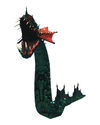
Locating
Hunting Serpents can be desirable for their drops, but finding one quickly is not intuitive.
- Serpents only spawn at night or during heavy rain (with or without thunderstorm). Light rain is not sufficient.
- Serpents that spawned from the night will despawn on morning. However, if the area is only visited during the night then they will remain there.
- Serpents that spawned from the rain will not despawn during the day and can be later found even during calm weather.
- When it is both night and heavy rain, there is no way to tell if the Serpent despawns on morning.
- Each zone has a chance to spawn a Serpent when a player sails through it. The chance is 5% when it is night time or raining, or 10% chance if it is both. A zone only attempts spawning every 1000 seconds so backtracking will not trigger more spawn attempts.
- Sailing to non-cardinal directions (north-west, north-east, south-west and south-east) can trigger more spawn attempts due to how zones are in a grid.
- Not all Serpents will spawn close enough to spot the player.
- Up to half[1] of the Serpents will spawn close enough to see the player and will attack on their own.
- Some[2] of the Serpents will spawn outside of player vision (render distance) and will always be missed.
- The rest can be spotted by a player scanning the boat's rear 180 degrees. Sailing at full-mast (as opposed to half-mast) may cause the player to miss spotting some spawns, but ultimately encounter more Serpents due to triggering more spawn attempts.
- With optimal searching, players should be able to find at least one Serpent per full night of sailing more often than 0.
Killing
Serpents can be killed at sea for their meat (Frost Arrows are most effective). For other drops, they must be killed on land or in shallow waters that allows picking up the drops under the water. It is also possible to jump in the water right after killing them to pick up the drops before they sink to the bottom of the ocean.
Serpents can be lured towards the land by sailing slow enough with a Karve or a Longship. However, they will retreat towards their spawn position if they are not able to attack for 60 seconds. For long distances, it is recommended to let them attack the ship once in a while. They do not despawn from retreating (except if it is a night time Serpent during the day time) and can be chased down again.
They can be further dragged onto the land by using an Abyssal harpoon. However, this is not required and can be difficult to do when playing alone due to the high stamina drain. While beached, serpents do not attack and instead try to flee towards the ocean.
The Abyssal harpoon continually drains stamina from the user while it is pulling an entity (i.e. when there is no slack). The leash breaks if the leashing player attacks with a different weapon or right-clicks. Ideally, the leashing player should get assistance from other players or creatures.
- ↑ Monte Carlo simulation resulting in 47% of spawned Serpents being within 50 meters of the boat path: https://jsfiddle.net/6xpnhdgL/. A delay between the Serpent spawning and being able to aggro will lower this value a little.
- ↑ Serpents can spawn up to 80 meters away while their render distance is from 64 to 128 meters (depends on the location of the underlying zone system).
